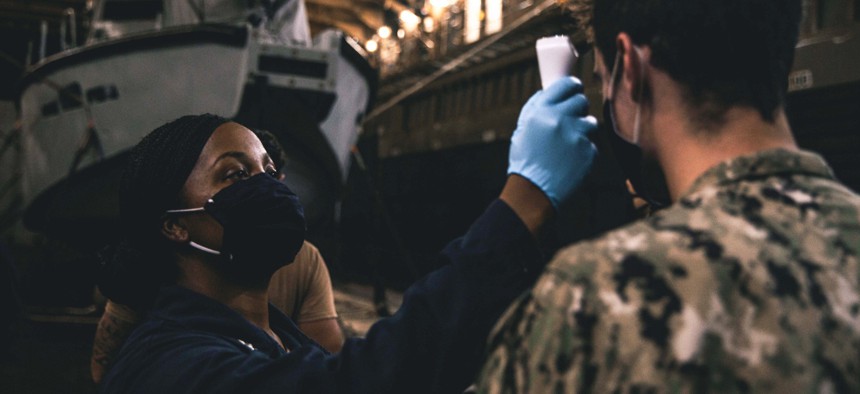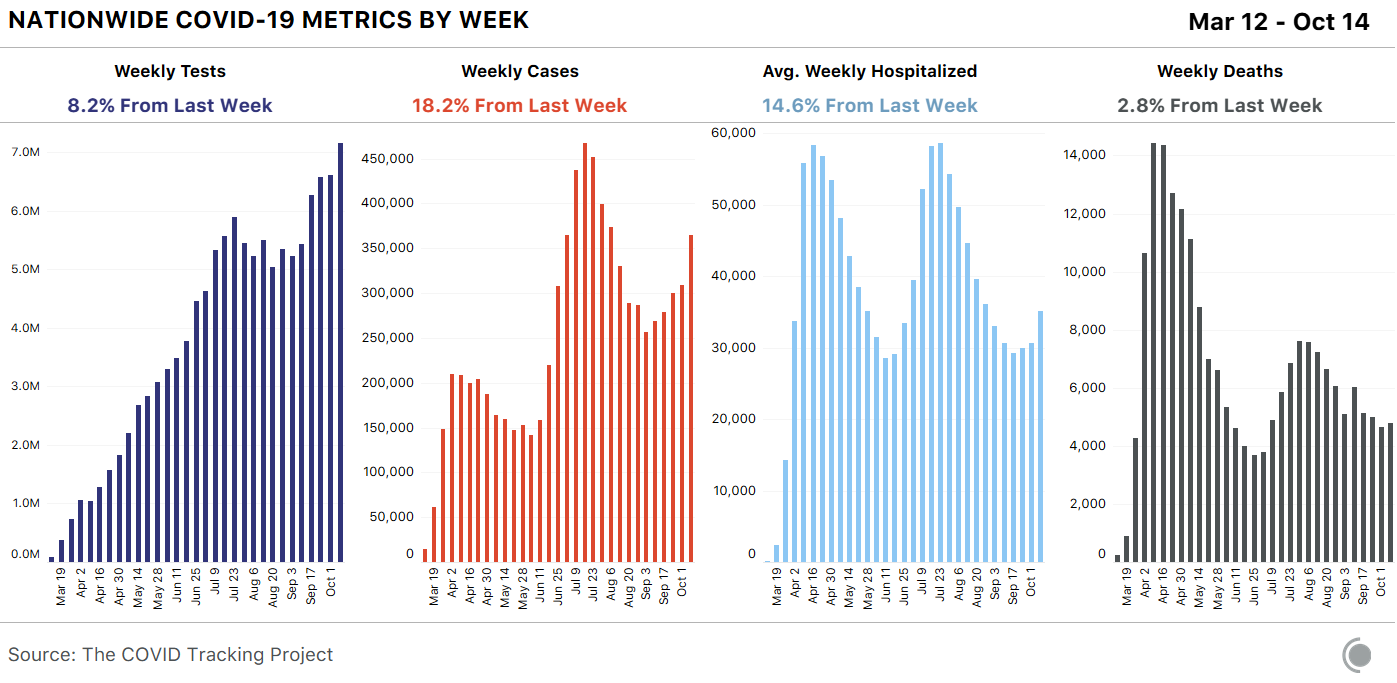
A Marine assigned to amphibious dock landing ship USS Comstock conducts COVID-19 mitigation procedures on sailors aboard Patrol Boats Mk VI assigned to Commander, Task Force 75 in the Philippine Sea, Oct. 6, 2020. Marine Corps Sgt. Manuel A. Serrano
The Third Coronavirus Surge Has Arrived
This week’s COVID-19 cases and hospitalizations make clear that the U.S. is once again sinking deeper into the pandemic.
After a month of warning signs, this week’s data make it clear: The third surge of the COVID-19 pandemic in the United States is under way. Outbreaks have been worsening in many states for more than a month, and new COVID-19 cases jumped 18 percent this week, bringing the seven-day average to more than 51,000 cases a day. Though testing rose by 8 percent nationally, that’s not enough of an increase to explain the steep rise in cases. Meanwhile, COVID-19 hospitalizations, which had previously been creeping upward slowly, jumped more than 14 percent from a week earlier.
Since last Wednesday, states reported 4,796 COVID-19 deaths, an increase of about 3 percent over the previous week. Since the start of the pandemic we have typically seen reported deaths lag behind reported cases by three to four weeks, although reporting delays seem to have worsened in some states, including Florida and Texas.
Our analysis is based on the official data we compile from 50 U.S. states, the District of Columbia, and five U.S. territories. Other sources confirm that the country is in trouble as we head further into fall: The New York Times, which collects official data at the county level, warned this morning that the U.S. is heading toward a new peak in COVID-19 cases. On the federal level, this week’s White House Coronavirus Task Force report (which is still not made public except by certain states) puts 26 states in the red zone based on new cases per capita, and an additional 19 states and the District of Columbia in the orange zone. As of this week, no U.S. states are in the task force’s green zone.
This week’s spike in new cases was spread across the country, rather than being concentrated in a few states, as we saw in the Northeast in the spring, in the Sun Belt in early June, and in the Midwest over the past few weeks. Seventeen states posted peak new-case days in the past week, including nine of 12 states in the Midwest and six of 11 states in the West.
Single-day case numbers have limited value because some states don’t report consistently or build up backlogs, then dump several days’ worth of test and case data in a single day. Nevertheless, when a state sets a new record for daily reported cases, it’s usually a bad sign. Of all the states that reported record highs this week, only Washington’s appears to be the result of reporting irregularities; the other 16 states all showed alarming overall case and hospital trends in the past week.

Cases in the Northeast, where the spread of COVID-19 slowed considerably during the summer after a dismal spring, are now rising: The seven-day average case count in the region has more than doubled in the past month. The Midwest has seen an 81 percent increase in COVID-19 cases in the same period.
The Dakotas continue to have the most cases per capita, with South Dakotarecording 990 cases per 1 million people and North Dakota reporting 921 cases per 1 million, based on seven-day averages.
The other states reporting the largest number of cases per capita were Wisconsin, Montana, and Missouri. Note, though, that this might not reflect the reality on the ground in Missouri, as a database error led to what the state called an “incorrectly inflated” count of cases for October 10. Missouri officials have not yet explained whether any case numbers were actually wrong, or were simply allocated to the wrong date. We will correct our count once the state updates its figures.
Montana posted a week-over-week decline in cases, but the state’s hospitalization count continues to rise. Unfortunately, rising hospitalizations are the rule rather than the exception in states around the country this week.
Last week, 41 states saw increases in hospitalizations, and this week the numbers increased in 42 states. Every single state in the Midwest save North Dakota reported more hospitalizations this week than they did on October 8, and only the West had more than two states record drops in hospitalization figures in that period.
We’ve seen two previous hospitalization peaks in the national data, each with its own characteristics. From mid-March to mid-June, COVID-19 hospitalizations rose abruptly from zero to 60,000 and gradually declined to a low of just under 30,000 people hospitalized. Although outbreaks across the country contributed to the national numbers, these spring and early-summer hospitalizations were mostly concentrated in the Northeast. On June 21, national hospitalizations began increasing again as rising numbers in the South and West countered falling hospitalizations in the Northeast. As the case surge concentrated in the Sun Belt states came under control, hospitalizations gradually fell again to just under 30,000 people in mid-September, when the third surge began showing up in the hospital data.
The surge in hospitalizations we’re seeing now looks a little different: It’s less abrupt, and much more geographically widespread. And this time, more states that experienced major outbreaks earlier in the year are seeing hospitalizations rise again.
In New York and New Jersey, where stringent public-health measures brought the devastating spring surge under control and kept numbers down all summer, COVID-19 hospitalizations have gone up 53 and 34 percent, respectively, since October 1. In Texas, where hospitalizations soared in the summer and have steadily declined through the fall but never dropped below 3,000, a new upswing is under way: The number of people hospitalized in the Lone Star State has grown 32 percent in the past three weeks. More than 4,000 people in Texas are hospitalized with COVID-19.
This post appears courtesy of The COVID Tracking Project. Artis Curiskis, Erin Kissane, Kara Oehler, Joanna Pearlstein, Sara Simon, Peter Walker, and Nadia Zonis contributed to this analysis.
This story was originally published by The Atlantic. Sign up for their newsletter.
NEXT STORY: 'Esper's Lie?' I Don't Think So



